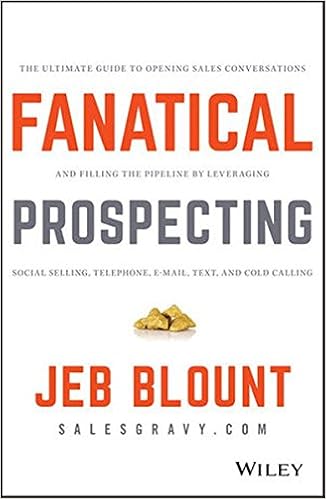
Until someone mentioned “Fanatical Prospecting,” I had never heard of the book or its author Jeb Blount. Noticing the book was #1 on Amazon’s telemarketing best seller list, I ordered a copy and began reading with an open mind.
The book, especially at the beginning and the very end, is about 50% standard sales motivation content covering well-trodden material like the amygdala/lizard brain, Amy Cuddy’s TED talk on body language, etc. However, the other 50% delivers very practical processes and templates that make the book one of the better sales books available. All told, I felt the book was a must read.
Here is my summary of key-take-ways:
1. Knowing that activity takes 90+ days to pay off, successful salespeople relentlessly fill their pipeline through a mixture of telephone, in-person, e-mail, social selling, text messaging, referrals, networking, inbound leads, trade shows, and cold calling.
2. Here is the brutal truth: Salespeople who ignore the phone fail.”
3. “Top performers organize their day into distinct time blocks dedicated to specific activities, concentrating their focus and eliminating distractions within those blocks… We schedule our prospecting blocks [on our calendars] into three “Power Hours” that are spread across the day—morning, midday, and afternoon.”
4. “While setting an appointment is your primary objective with prospects you have already prequalified as potential buyers, gathering information is your primary objective with prospects you have not qualified.”
5. “Our data and data that we've gathered and analyzed from a diverse set of sources indicate that it takes, on average: 1 to 3 touches to reengage an inactive customer 1 to 5 touches to engage a prospect who is in the buying window and is familiar with you and your brand 3 to 10 touches to engage a prospect who has a high degree of familiarity with you or your brand, but is not in the buying window 5 to 12 touches to engage a warm inbound lead 5 to 20 touches to engage a prospect who has some familiarity with you and your brand—buying window dependent 20 to 50 touches to engage a cold prospect who does not know you or your brand.”
6. “The bottom line is people don't want to be pitched or “sold” on social media. They prefer to connect, interact, and learn. For this reason, the social channel is better suited to building familiarity, lead nurturing, research, nuanced inbound prospecting, and trigger-event awareness.”
7. “Prospects meet with you for their reasons, not yours. You must articulate the value of spending time with you in the context of what is most important to them. Your message must demonstrate a sincere interest in listening to them, learning about them, and solving their unique problems.”
8. “Just saying, “I'd like 15 minutes of your time because I want to learn more about you and your company” works surprisingly well with many prospects.”
9. “When salespeople ask me when they should leave a voice mail, I always answer, “When it matters.”… Keep voice mail messages to 30 seconds.”
10. “Timing Teleprospecting Calls Is a Losing Strategy… So, forget about timing your calls and commit instead to a daily, first-thing-in-the-morning call block.”
11. “The feeling of rejection happens the moment you get a reflex response, brush-off, or objection (RBO)… Overcoming doesn't work. There is a universal law of human behavior: You cannot argue another person into believing that they are wrong. The more you push another person, the more they dig their heels in and resist you… There is a better way. Rather than attempting to overcome—defeating or prevailing over your prospect—you should disrupt their expectations and thought patterns when they push back with a no. The key is a disruptive statement or question that turns them around so that they lean toward you rather than move away from away from you… When they say they're busy, instead of arguing them into how you will only take a little bit of their time, say, “I figured you would be.” Agreeing with them disrupts their thought pattern… When they say, “Just send me some information,” say, “Tell me specifically what you are looking for.” This calls their bluff and forces engagement… When they say, “I'm not interested,” say, “That makes sense. Most people aren't.” Their brain isn't ready for you to agree with them… One phrase you want to avoid is “I understand.” When you use the phrase “I understand,” you sound just like every other schmuck who uses this phrase as insincere filler so they can get back to pitching. It demonstrates zero empathy and tells your prospect that you are not listening and don't care.”
12. The salespeople-help-salespeople hack is an awesome secret weapon.”
13. “Truly effective salespeople understand that it is all about asking the prospect the right questions and demonstrating that you can help them solve a particular problem or issue.”
14. Don't send bulk e-mail. Prospecting e-mail is one to one. It is one e-mail from your address sent to one individual, one e-mail at a time… Avoid attaching images… Avoid hyperlinks… never use “Hi” or “Hello” or “Dear” or any other salutation in front of your prospect's name. No one in business does that except salespeople. “Hi __” is a complete turnoff for prospects.”
No comments:
Post a Comment